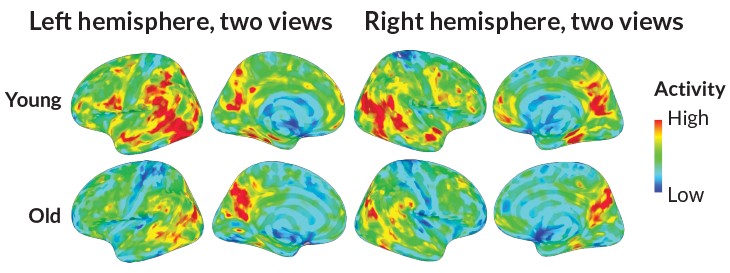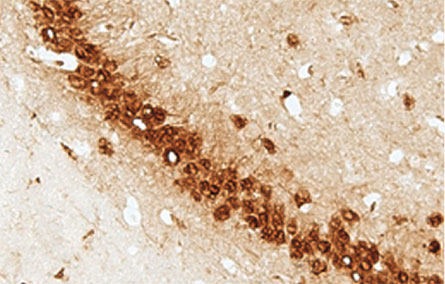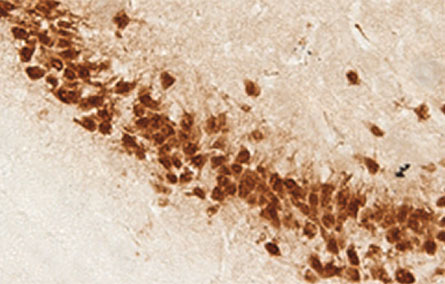The brain’s blueprint for aging is set early in life
An elderly brain has some telling similarities to a developing brain
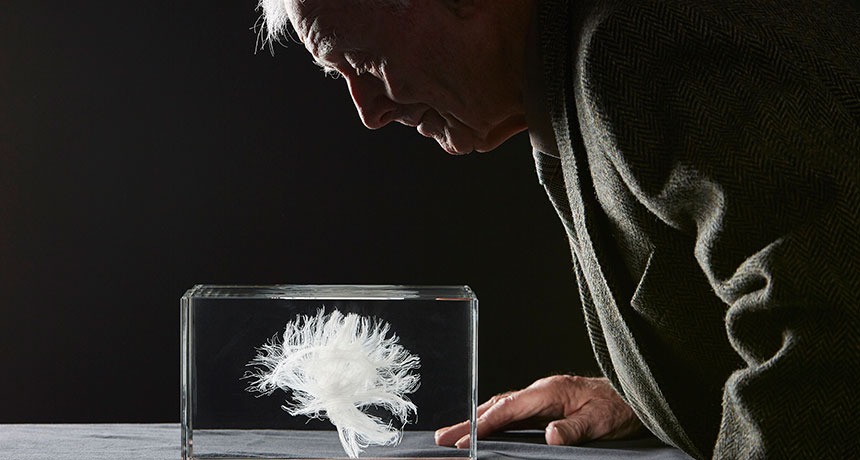
special report
National Museums Scotland
If you’ve ever watched a baby purse her lips to hoot for the first time, or flash a big, gummy grin when she sees you, or surprise herself by rolling over, you’ve glimpsed the developing brain in action. A baby’s brain constructs itself into something that controls the body, learns and connects socially.
Spending time with an older person, you may notice signs of slippage. An elderly man might forget why he went into the kitchen, or fail to anticipate the cyclist crossing the road, or muddle medications with awkward and unfamiliar names. These are the signs of the gentle yet unrelenting neural erosion that comes with normal aging.
These two seemingly distinct processes — development and aging — may actually be linked. Hidden in the brain-building process, some scientists now suspect, are the blueprints for the brain’s demise. The way the brain is built, recent research suggests, informs how it will decline in old age.
That the end can be traced to the beginning sounds absurd: A sturdily constructed brain stays strong for decades. During childhood, neural pathways make connections in a carefully choreographed order. But in old age, this sequence plays in reverse, brain scans reveal. In both appearance and behavior, old brains seem to drift backward toward earlier stages of development. What’s more, some of the same cellular tools are involved in both processes.
Probing the connections between growing and aging may reveal how time affects the brain. And with a deeper understanding of brain aging, and the tools involved, scientists might be able to slow — or even stop — mental decline.
That’s a lofty goal, made even more challenging by the multitude of theories from a diversity of researchers that aim to explain why and how the brain ages. Everybody focuses on a different aspect of the aging brain, leaving no one with a sense of the whole process, says epigeneticist Art Petronis of the Center for Addiction and Mental Health in Toronto. It’s like people trying to put together a giant jigsaw puzzle from separate rooms, each with only a few pieces in hand. So far, people studying how the brain ages have found only the evidence they can grab.
Petronis and others are intrigued by the idea that the brain’s early life holds clues to its end. “You see blips here and blips there,” he says. “This critical mass is accumulating.”
Other scientists, including Caleb Finch of the University of Southern California, in Los Angeles, caution against falling for appealing but overly simple explanations for aging. As a gerontologist who has been thinking about aging for 50 years, he has seen aging theories come and go, a perspective that makes him skeptical that the complex process can be reduced to the notion that it’s just development in reverse. “The more we poke into biology, the more wondrously complex it is,” he says.
Nonetheless, there’s something to the notion that aging starts early. “We are born dying,” Finch says. And poking at that idea just might lead somewhere.
Head start
When the human brain makes its first appearance in the third week of gestation, it is no more than a minuscule smear of indistinct cells. This glob then grows at a furious rate up through the preschool years. At the same time, these accumulating brain cells begin to take on specific jobs, changing from generalists to specialists. Nerve cells are born and migrate to their final destinations, linking up in precise order to form the high-speed neural connections that enable memory, emotion and thought. And scientists now realize that the way the brain is built has lifelong effects.
In 1932 and 1947, nearly every Scottish 11-year-old sat down to take an intelligence test. Decades later, their scores have matured into academic gold, offering scientists a rare opportunity to see how intelligence fares with age. In 1999, scientists led by Ian Deary of the University of Edinburgh got back in touch with as many of the long-ago test takers as possible, forming a group of more than 1,000 people — ranging in age from 80 to 95 — called the Lothian Birth Cohort. Deary and colleagues have studied the group in detail, and one factor rises above the rest: People with higher intelligence scores at age 11 were more likely to have better thinking skills in old age.
Childhood intelligence wasn’t the only factor, though. From the start, Deary and his colleagues cast a wide net, imaging participants’ brains and examining genetics, lifestyles, health and social factors. “We were right to do so, because there is a large range of mostly small influences on people’s cognitive aging,” he says. But the fact that intelligence at age 11 can partially predict who will be sharp into their 90s suggests that a long-lasting brain must be solidly constructed.
One way in which the brain is built well involves its white matter — tracts of tissue that connect distant brain regions, allowing for quick communication. And in fact, members of the Lothian Birth Cohort with healthier white matter in old age, measured by an MRI-based brain scan method called diffusion tensor imaging, performed better on tests of brain function, Deary and colleagues found.
Mature neural highways take decades to develop. Brain areas are still solidifying into a person’s thirties. The later-blooming brain regions oversee jobs like impulse control and judgment, two well-known weak spots among teenagers.
These slow-to-grow brain networks are the first to go in old age, neuroscientist Gwenaëlle Douaud of the University of Oxford and colleagues found. Networks of nerve cells (the gray matter) are guided by a “last in, first out” rule, brain scans of 484 people from 8 to 85 years of age indicate. “What we show is a precise mirroring for these regions,” she says.
These networks, which reach their peak around age 39 for men and age 41 for women, handle sophisticated jobs, like merging multiple kinds of information together, she says. And sure enough, people with seemingly healthier neural connections had better memories, Douaud’s team reported in the Proceedings of the National Academy of Sciences in 2014.
Special no more
As neural connections come and go with age, brain cells themselves change in a way that harkens to the brain’s early days. Human brain cells are a dazzlingly diverse crew that handle a variety of jobs, from sending crucial signals to clearing out clutter. Yet these workers come from common ancestors that eventually specialize as the brain matures. In old age, some of these specialists seem to revert, becoming more similar to one another once again.
Cells are controlled by genes, but those genes don’t always behave the same way across a life span. Markers on cells’ DNA can dial activity up or down, controlling how much protein is made from a particular gene. In the case of brain cells, these epigenetic marks, many of which are laid down early in life in response to the environment, are one of the things that make nerve cells distinct from one another. So a nerve cell in the hippocampus, a structure important for memory, has an epigenetic fingerprint that’s distinct from that of a nerve cell in the cerebellum, a part of the brain important for movement.
But with age, these marks become less distinct, both between regions in a single brain and even among different people, Petronis says. After age 75, brain cells become more similar to one another, both in their epigenetic marks and their genes’ behaviors, he and colleagues reported April 28 in Genome Biology.
That was a big surprise, he says. It contradicts a popular concept called epigenetic drift, which says that with time, epigenetic stamps accumulate on cells, making the cells more distinct. But Petronis’ results suggest that once nerve cells hit a certain age, they begin to experience a different kind of drift, back toward sameness.
Petronis cautions that his results are preliminary and need to be reproduced. But he says they point to the link between development and aging. “Developmental epigenetic marks and aging epigenetic marks seem to be overlapping to some extent,” he says.
It’s not just nerve cells that show tendencies toward conformity in old age. Microglia do too, researchers recently found. These brain cells have multiple job descriptions, including fighting off pathogens, snipping unnecessary neural connections and hoovering up cellular debris. Microglia in different parts of the brain use their genes in specific ways — making more or fewer proteins as needed. This protein customization helps the microglia do their diverse jobs.
But this specificity diminishes with age. Microglia in the hippocampus actually become less diverse as mice get older, neuroscientist Barry McColl of the University of Edinburgh and colleagues reported in the March Nature Neuroscience. “It wasn’t something we were looking for at all,” McColl says.
The unexpected results hint that a slow loss of specialization might cause trouble during aging by hindering cells as they try to do their particular jobs, McColl says. “That’s the overriding — but quite speculative — theory we’ve got at the moment.”
Loss of specialization with age may happen not just in single brain cells, but in the networks they form. Any time a person sees, hears or feels something, the brain fires off a pattern of highly specific neural responses. Cognitive neuroscientist Bradley Buchsbaum of Baycrest Health Sciences in Toronto and colleagues wondered if elderly brains might lose the ability to form these sharp neural reflexes.
For Buchsbaum’s study, 28 adults — half young and half old — watched video clips while undergoing functional MRI brain scans, which detect changes in blood flow that represent the activity of big collections of nerve cells. As participants watched snippets of President Barack Obama giving a speech, a skateboarding dog and a meat slicer in action, their brains responded to the sights and sounds. Later, they were asked to remember the videos.
In people ages 21 to 32, each type of video evoked a specific and sharp neural fingerprint, both as people saw the videos for the first time and remembered them later. The sharper the fingerprint, the better the memory, the researchers reported in 2014 in the Journal of Neuroscience.
But in people 64 to 78, the neural signatures became fuzzy and less distinct, particularly when participants tried to remember the videos. Buchsbaum calls this fuzziness dedifferentiation. “In the beginning, you’ve got this blank slate,” he says. But along the way, brain areas diversify and connect in intricate ways. Dedifferentiation is an about-face toward that blank slate.
Story continues after graphic
Other observations of the old brain seem to fit this idea. Language, for instance, is handled by the left side of the young adult brain. But in elderly people, both hemispheres are required to handle the job. And in older people, remembering can activate both sides of the frontal cortex, instead of just one as in younger people.
Some cognitive psychologists caution against making too much of these signs of generalization. Understanding spoken language is one of the tasks that scientists thought might become hazier in the brain with age. But when psychologist Karen Campbell of Harvard University and colleagues asked old people to simply listen to language while in a scanner, without any additional tests, the task elicited brain responses that looked similar to the specialized responses of younger people.
Campbell’s results, published May 11 in the Journal of Neuroscience, suggest that the extra work of experimental tests — and not the task itself — may take more brainpower in older people, an addition that may confound simple interpretations. Her results are “a challenge to other scientists,” she says. “Try a more natural approach.”
Snip early and snip late
Although scientists are still probing the relationship between brain construction and deconstruction, it’s becoming clear that the brain relies on some of the same tools for both jobs.
One of the most tantalizing finds has to do with microglia. The synaptic pruning that these cells do is crucial for a growing brain, shaping the tangle of new nerve cells into an efficient, elegantly connected information processor.
This snipping may happen late in life, too, and that may not be a good thing. Synapses in the hippocampi of mice and humans become sparser with age. But when mice were engineered to lack a protein that helps mark synapses for destruction, old mice no longer showed synapse thinning, neuro-scientist Cynthia Lemere of Brigham and Women’s Hospital in Boston and colleagues reported last year in the Journal of Neuroscience. These lucky mice with an abundance of synapses performed better on memory tests and learning, too.
Other recent results from neuroscientist Beth Stevens’ lab at Harvard hint that excessive synapse pruning may play a role in Alzheimer’s disease (SN: 4/30/16, p. 6) and schizophrenia, though what kicks off the pruning is a mystery. “One of the really big questions is what turns this pathway on in aging, or in Alzheimer’s or other diseases?” she says. “Are they the same kind of signals that we’ve identified in development, or could they be completely different?”
Finding those signals and other molecules in the body that could stall some of the brain’s aging processes might lead to better treatments for Alzheimer’s, schizophrenia or even the mental decline that comes with healthy aging.
But just because things appear to be similar doesn’t mean that they are the same thing, cautions neurologist Tony Wyss-Coray of Stanford University. Finding a developmental process that’s also at work during aging “doesn’t mean that we are triggering a developmental program,” he says. A protein that becomes active again later in life is not necessarily trying to restart development.
A lack of clarity on brain aging hasn’t stopped scientists from floating ideas for delaying the mental trouble that comes with age. One notion is to wipe out age-related epigenetic changes on brain cells, a concept called “epigenetic rejuvenation.” Scientists might be able to overwrite epigenetic changes using the same cellular tools that manage those marks.
Other researchers are looking to the blood for answers. Wyss-Coray and others have turned up tantalizing evidence that some mysterious contents in young blood can rejuvenate the older brain. Young blood spurred more neural connections and stimulated the birth of newborn nerve cells in mice. The brain changes came with better memory and a sharpened sense of smell (SN: 5/31/14, p. 8). The researchers are trying to figure out which blood components led to the improvements, described in Nature Medicine in 2014, and are testing whether plasma from young people can help the brains of older people with Alzheimer’s disease.
Given the parallels emerging between development and aging, these approaches that borrow from youth to stave off decrepitude start to make sense. “Sometimes things start converging,” Petronis says, “and it’s very interesting to see that process.”
This article appears in the July 23, 2016, issue of Science News with the headline, “The mature mind.”
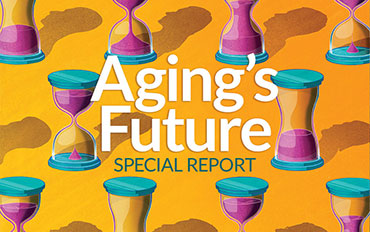
 A healthy old age may trump immortality
A healthy old age may trump immortality Organisms age in myriad ways — and some might not even bother
Organisms age in myriad ways — and some might not even bother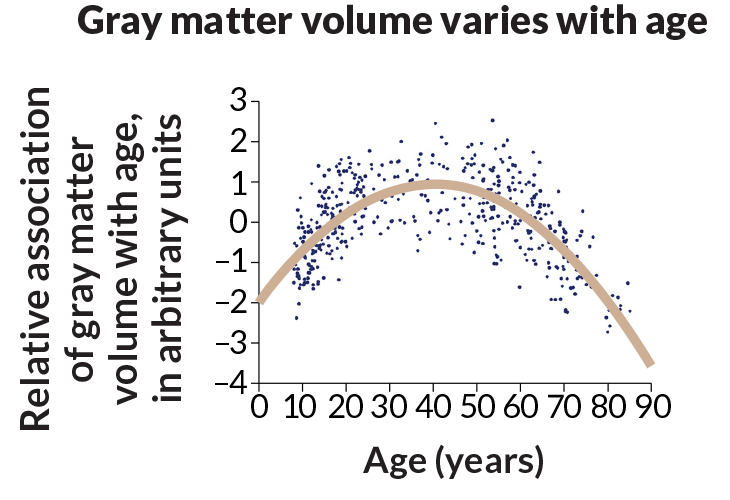 Source: G. Douaud et al/PNAS 2014
Source: G. Douaud et al/PNAS 2014

